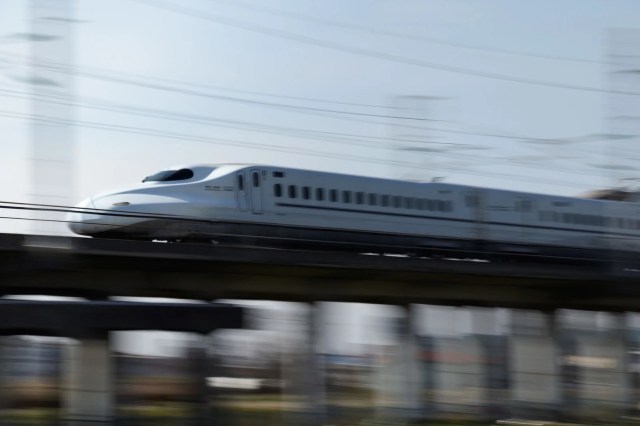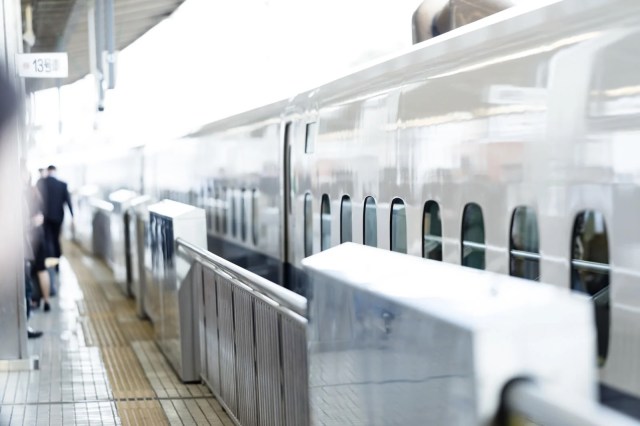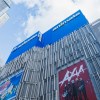
New policy affects popular Tokyo-Kyoto-Osaka route of high-speed rail network.
The quickness and convenience of Japan’s Shinkansen bullet train network makes it most travelers’ preferred way to get around Japan. Soon, though, it looks like the Shinkansen is going to get a little less convenient, and a bit more expensive too.
Shinkansen tickets are divided into two basic types: reserved seats and unreserved seats. Whereas reserved tickets are only good for a specified seat on a specific train, unreserved tickets allow you to sit in any unoccupied seat in an unreserved-seat car on a Shinkansen train headed to your destination that day. That makes unreserved seats a nice option if you want greater flexibility in your departure time (maybe because you’re not sure how much sightseeing you’ll be doing in a town before leaving to go somewhere else), and they’re also less expensive than reserved seats.
However, Central Japan Railway Company, also known as JR Central or JR Tokai, says it will be abolishing unreserved seats on its fastest class of Shinkansen train, the Nozomi, during peak travel seasons. JR Central manages the Tokaido Shinkansen portion of the network, which runs from Tokyo to Osaka (and includes Kyoto), but this abolition of unreserved Nozomi seats will also apply to the Sanyo Shinkansen section, which the Tokaido Shinkansen trains flow into/out of between Osaka and Fukuoka. Currently, three cars of every Nozomi train is for unreserved seats.
JR Central says this policy change will take effect at the three busiest travel times of the year: the New Year’s, Golden Week (late-April/early-May), and Obon (early August) vacation periods. During those times, all Nozomi Shinkansen cars will be reserved seat-only.
The company says the new policy is a response to overcrowding of the unreserved-seat train cars during those peak periods. As the cars fill up, passengers with unreserved tickets who are unable to secure a seat end up waiting on the station platform in hopes of getting a seat on the next train, JR Central says, and the increased congestion is making the boarding/disembarking process for passengers take longer, leading to delays in the trains’ departures. Under the new reserved seats-only system for Nozomi Shinkansen trains, the company says that not only will getting on and off the train go more smoothly “our customers will no longer need to wait for a long time [for a train with an empty seat].”
That last part sounds a little like JR Tokai’s previous attempt to spin into a positive its addition in 2019 of new rules requiring Shinkansen passengers with suitcases to purchase reserved-seat tickets and make a luggage reservation. There are a few silver linings, though. The abolition of non-reserved seats on peak-period Nozomi trains will increase their number of reserved seats by about 20 percent per train, so in terms of available quantity, snagging a reserved-seat ticket will be a little easier than it would otherwise. Starting October 1, the EX Service online reservation system for Shinkansen tickets will also be extending the amount of time in advance reservations can be made, allowing you to book them up to a year ahead of time. JR Central has also said that even during peak travel times, non-reserved-seat tickets will still be offered for its slower classes of Shinkansen trains, Hikari, Kodama, Mizuho, and Sakura.
The reserved seat-only Nozomi policy will take effect for the first time later this year between December 28 and January 4.
Source: JR Central via Jin
Top image: Pakutaso
Insert image: Pakutaso
● Want to hear about SoraNews24’s latest articles as soon as they’re published? Follow us on Facebook and Twitter!


 Tokaido Shinkansen ending in-train food/drink sales for all non-first-class-passenger cars
Tokaido Shinkansen ending in-train food/drink sales for all non-first-class-passenger cars Free Shinkansen tickets for kids travelling with parents during special JR promotion
Free Shinkansen tickets for kids travelling with parents during special JR promotion Japan’s Shinkansen bullet trains to remove all onboard payphones
Japan’s Shinkansen bullet trains to remove all onboard payphones Japan Rail now accepting suggestions for how to use a car on the Nozomi bullet train in March 2022
Japan Rail now accepting suggestions for how to use a car on the Nozomi bullet train in March 2022 Japan’s Shinkansen bullet train will start offering wider seats, but will charge more for them too
Japan’s Shinkansen bullet train will start offering wider seats, but will charge more for them too Japan’s new difficult-to-drink-from beer glass protects your liver, but it’s a brutal experience
Japan’s new difficult-to-drink-from beer glass protects your liver, but it’s a brutal experience How to order snacks on a Shinkansen bullet train in Japan
How to order snacks on a Shinkansen bullet train in Japan Caffeinated ramen for gamers that you can eat with one hand going on sale in Japan
Caffeinated ramen for gamers that you can eat with one hand going on sale in Japan Hello, cosmetics! Clinique teams up with Hello Kitty this summer for first-time collaboration
Hello, cosmetics! Clinique teams up with Hello Kitty this summer for first-time collaboration Demon Slayer: Kimetsu no Yaiba gets new roller coaster attractions and food at Universal Studios Japan
Demon Slayer: Kimetsu no Yaiba gets new roller coaster attractions and food at Universal Studios Japan To combat declining birth rate, Japan to begin offering “Breeding Visas” to foreigners
To combat declining birth rate, Japan to begin offering “Breeding Visas” to foreigners High-fashion Totoro cuddle purse is like an elegant stroll in the forest【Photos】
High-fashion Totoro cuddle purse is like an elegant stroll in the forest【Photos】 Gigantic new anime store opening soon in Tokyo, and here’s a sneak-peek【Photos】
Gigantic new anime store opening soon in Tokyo, and here’s a sneak-peek【Photos】 We investigate the newly released film revival of Hayao Miyazaki’s Sherlock Hound
We investigate the newly released film revival of Hayao Miyazaki’s Sherlock Hound Doraemon found buried at sea as scene from 1993 anime becomes real life【Photos】
Doraemon found buried at sea as scene from 1993 anime becomes real life【Photos】 Nintendo history you can feel – Super NES, N64, and GameCube controllers become capsule toys
Nintendo history you can feel – Super NES, N64, and GameCube controllers become capsule toys “The most Delicious Cup Noodle in history” – Japan’s French Cup Noodle wins our heart【Taste test】
“The most Delicious Cup Noodle in history” – Japan’s French Cup Noodle wins our heart【Taste test】 Starbucks releases a cute Frappuccino and Unicorn Cake…but not in Japan
Starbucks releases a cute Frappuccino and Unicorn Cake…but not in Japan Kyoto Tower mascot termination reveals dark side behind cute Japanese characters
Kyoto Tower mascot termination reveals dark side behind cute Japanese characters McDonald’s Japan’s Soft Twist Tower: A phantom ice cream only sold at select branches
McDonald’s Japan’s Soft Twist Tower: A phantom ice cream only sold at select branches Yabai Ramen: What makes this Japanese ramen so dangerous?
Yabai Ramen: What makes this Japanese ramen so dangerous? Finally! Nintendo Japan expands Switch 8-bit controller sales to everybody, Online member or not
Finally! Nintendo Japan expands Switch 8-bit controller sales to everybody, Online member or not Japanese government wants to build luxury resorts in all national parks for foreign tourists
Japanese government wants to build luxury resorts in all national parks for foreign tourists 10 things you should buy at 7-Eleven in Japan
10 things you should buy at 7-Eleven in Japan Studio Ghibli releases anime heroine cosplay dresses that are super comfy to wear
Studio Ghibli releases anime heroine cosplay dresses that are super comfy to wear Woman charged for driving suitcase without a license in Osaka
Woman charged for driving suitcase without a license in Osaka Studio Ghibli unveils My Neighbour Totoro miniature house model
Studio Ghibli unveils My Neighbour Totoro miniature house model Kyoto experiencing problems with foreign tourists not paying for bus fares, but not on purpose
Kyoto experiencing problems with foreign tourists not paying for bus fares, but not on purpose Fighting mild hunger with a Japanese soda that turns into jelly in the stomach【Taste test】
Fighting mild hunger with a Japanese soda that turns into jelly in the stomach【Taste test】 Studio Ghibli’s Howl’s Moving Castle tapestry unveiled in Japan for first time
Studio Ghibli’s Howl’s Moving Castle tapestry unveiled in Japan for first time McDonald’s new Happy Meals offer up cute and practical Sanrio lifestyle goods
McDonald’s new Happy Meals offer up cute and practical Sanrio lifestyle goods Sales of Japan’s most convenient train ticket/shopping payment cards suspended indefinitely
Sales of Japan’s most convenient train ticket/shopping payment cards suspended indefinitely Sold-out Studio Ghibli desktop humidifiers are back so Totoro can help you through the dry season
Sold-out Studio Ghibli desktop humidifiers are back so Totoro can help you through the dry season Japanese government to make first change to romanization spelling rules since the 1950s
Japanese government to make first change to romanization spelling rules since the 1950s Foreigner’s request for help in Tokyo makes us sad for the state of society
Foreigner’s request for help in Tokyo makes us sad for the state of society Ghibli founders Toshio Suzuki and Hayao Miyazaki contribute to Japanese whisky Totoro label design
Ghibli founders Toshio Suzuki and Hayao Miyazaki contribute to Japanese whisky Totoro label design Tokyo’s most famous Starbucks is closed
Tokyo’s most famous Starbucks is closed Princesses, fruits, and blacksmiths: Study reveals the 30 most unusual family names in Japan
Princesses, fruits, and blacksmiths: Study reveals the 30 most unusual family names in Japan Is the new Shinkansen Train Desk ticket worth it?
Is the new Shinkansen Train Desk ticket worth it? Shinkansen will require reservations for large suitcases, charge penalty fees for those without
Shinkansen will require reservations for large suitcases, charge penalty fees for those without New Shinkansen bullet train design revealed for Nagasaki extension
New Shinkansen bullet train design revealed for Nagasaki extension Shinkansen driver disciplined for taking poop break while train was going 150 kilometers an hour
Shinkansen driver disciplined for taking poop break while train was going 150 kilometers an hour Get the most out of your visit to Japan with these tourist-only deals 【Ninja Life Skills】
Get the most out of your visit to Japan with these tourist-only deals 【Ninja Life Skills】 Schedule released for Japan’s “Contemporary art bullet train”
Schedule released for Japan’s “Contemporary art bullet train” All-you-can-ride Shinkansen deal coming to Japan for a limited time
All-you-can-ride Shinkansen deal coming to Japan for a limited time New private rooms on Tokaido Shinkansen change the way we travel from Tokyo to Kyoto
New private rooms on Tokaido Shinkansen change the way we travel from Tokyo to Kyoto New JR Shinkansen-inclusive rail pass is a huge bargain, great way to help out a region in need
New JR Shinkansen-inclusive rail pass is a huge bargain, great way to help out a region in need Potentially dirty and broken used Shinkansen food/beverage carts on sale in Japan for 100,000 yen
Potentially dirty and broken used Shinkansen food/beverage carts on sale in Japan for 100,000 yen All Japan Railway Tokyo trains to finally get security cameras starting this summer
All Japan Railway Tokyo trains to finally get security cameras starting this summer Shinkansen station platforms now have…Baskin Robbins ice cream vending machines!
Shinkansen station platforms now have…Baskin Robbins ice cream vending machines! Disney Shinkansen coming to Japan’s rails, starts service this month
Disney Shinkansen coming to Japan’s rails, starts service this month A guide to riding the Shinkansen bullet train with a terrible-twos kid
A guide to riding the Shinkansen bullet train with a terrible-twos kid JR group offers all-you-can-ride passes for older couples in “Full Moon Couple Green Pass” deal
JR group offers all-you-can-ride passes for older couples in “Full Moon Couple Green Pass” deal
Leave a Reply